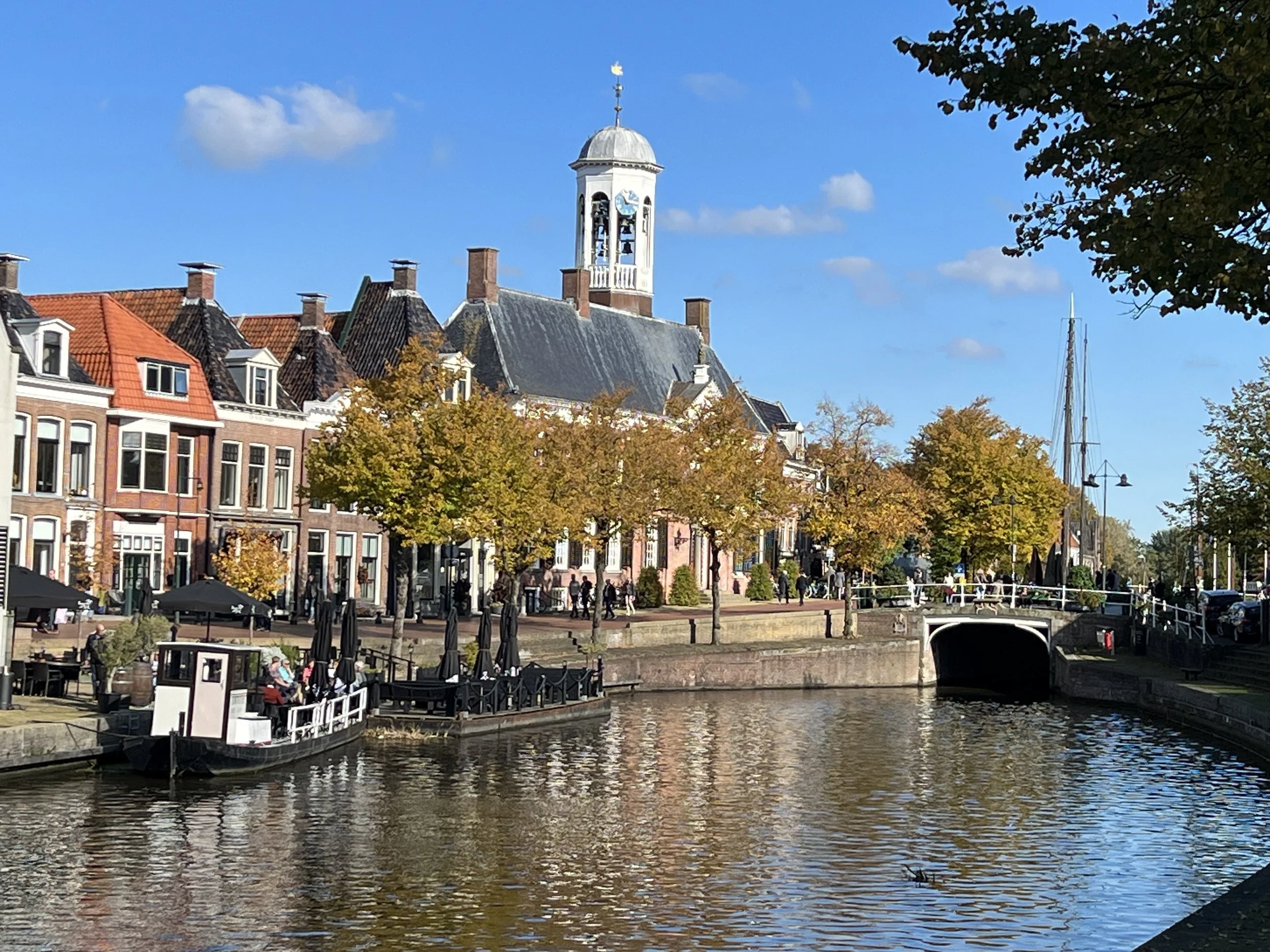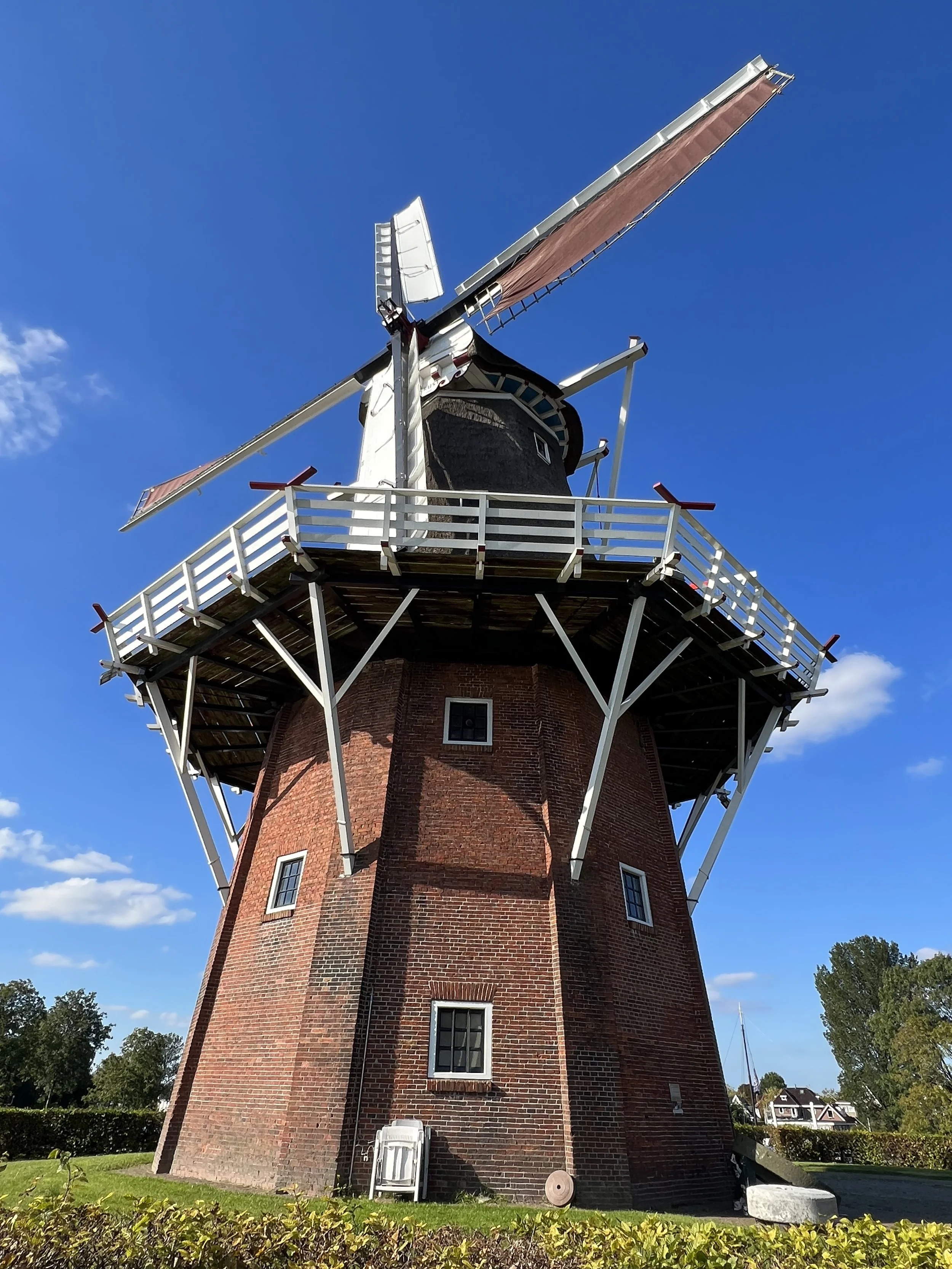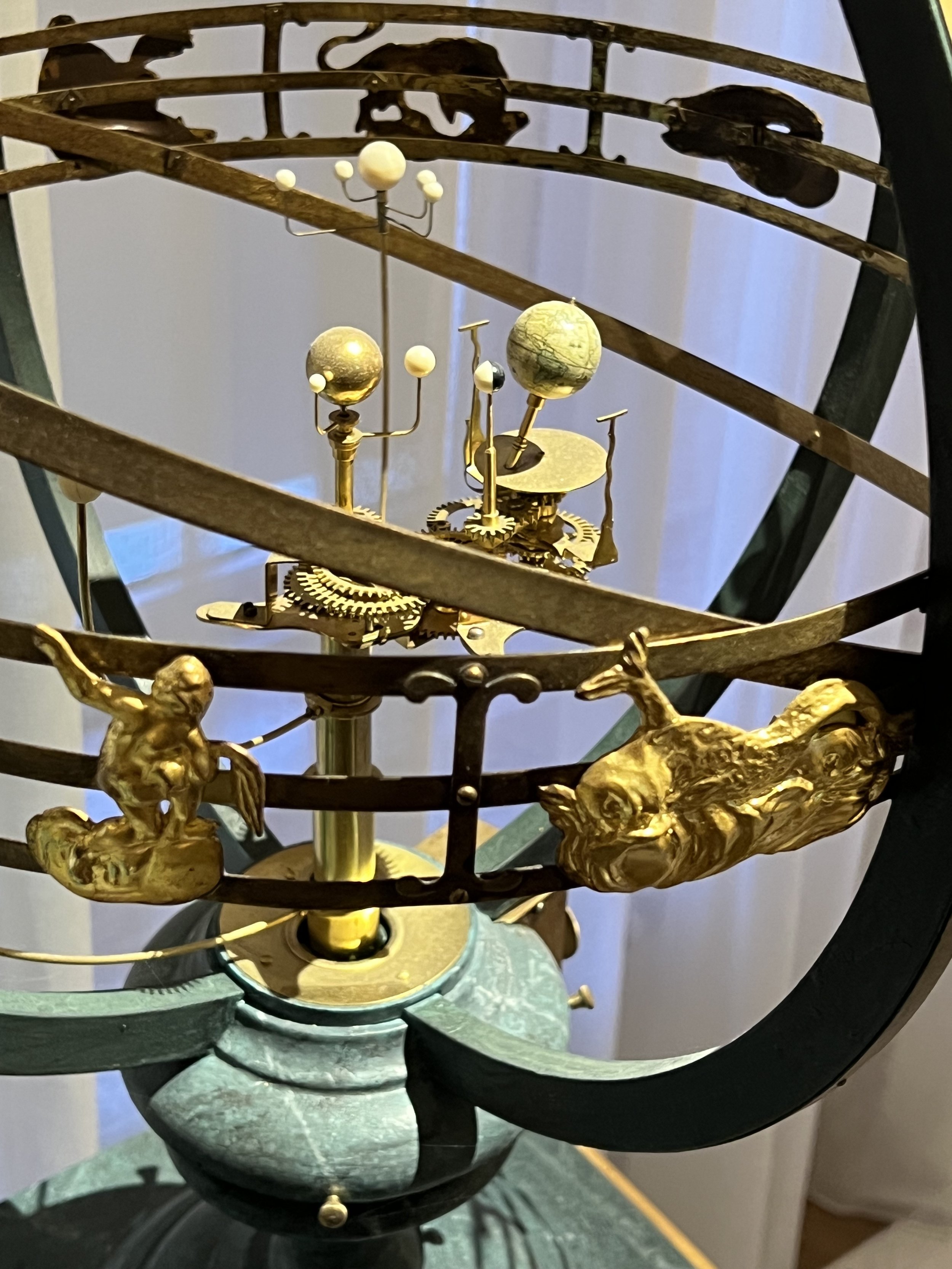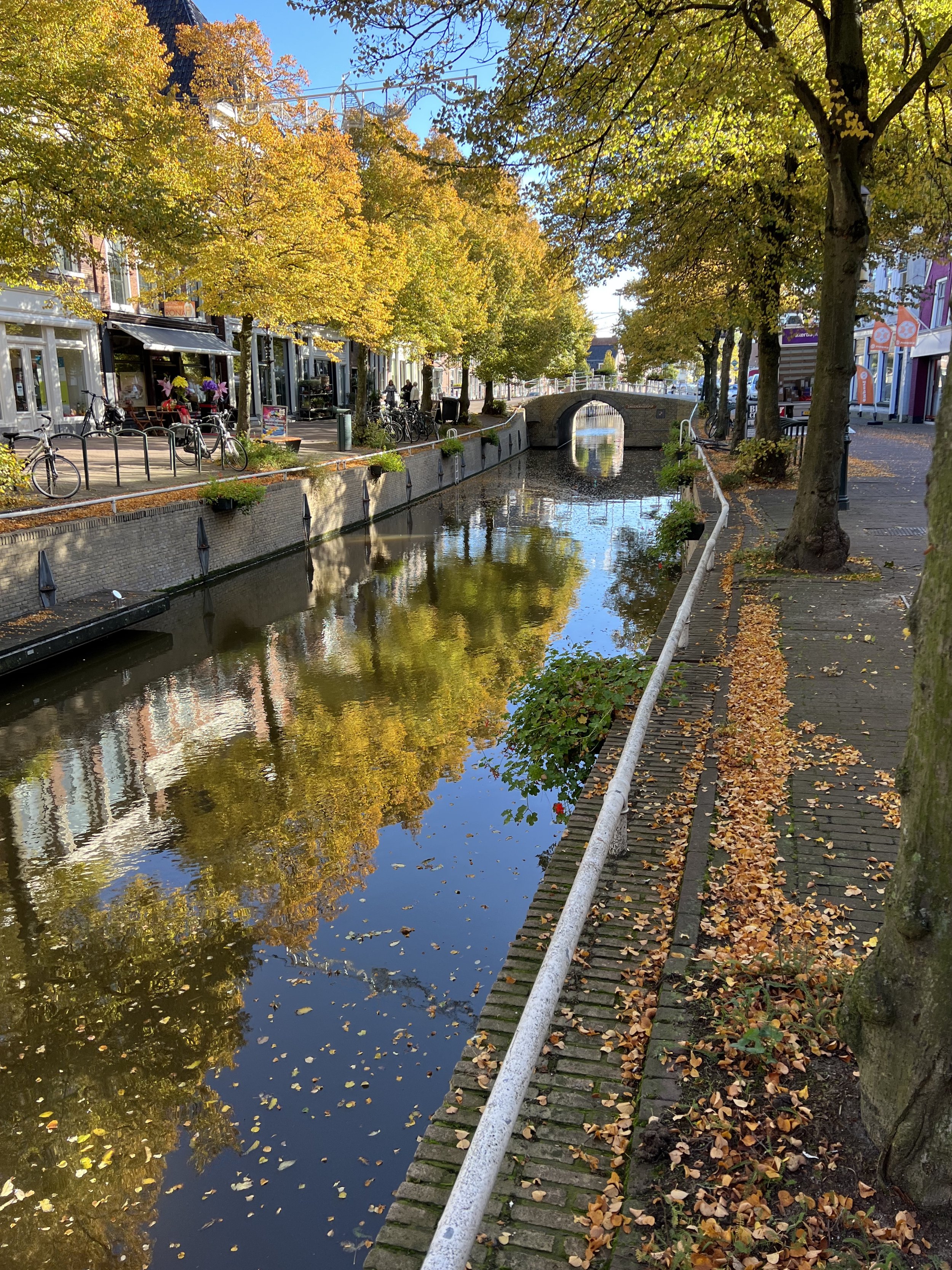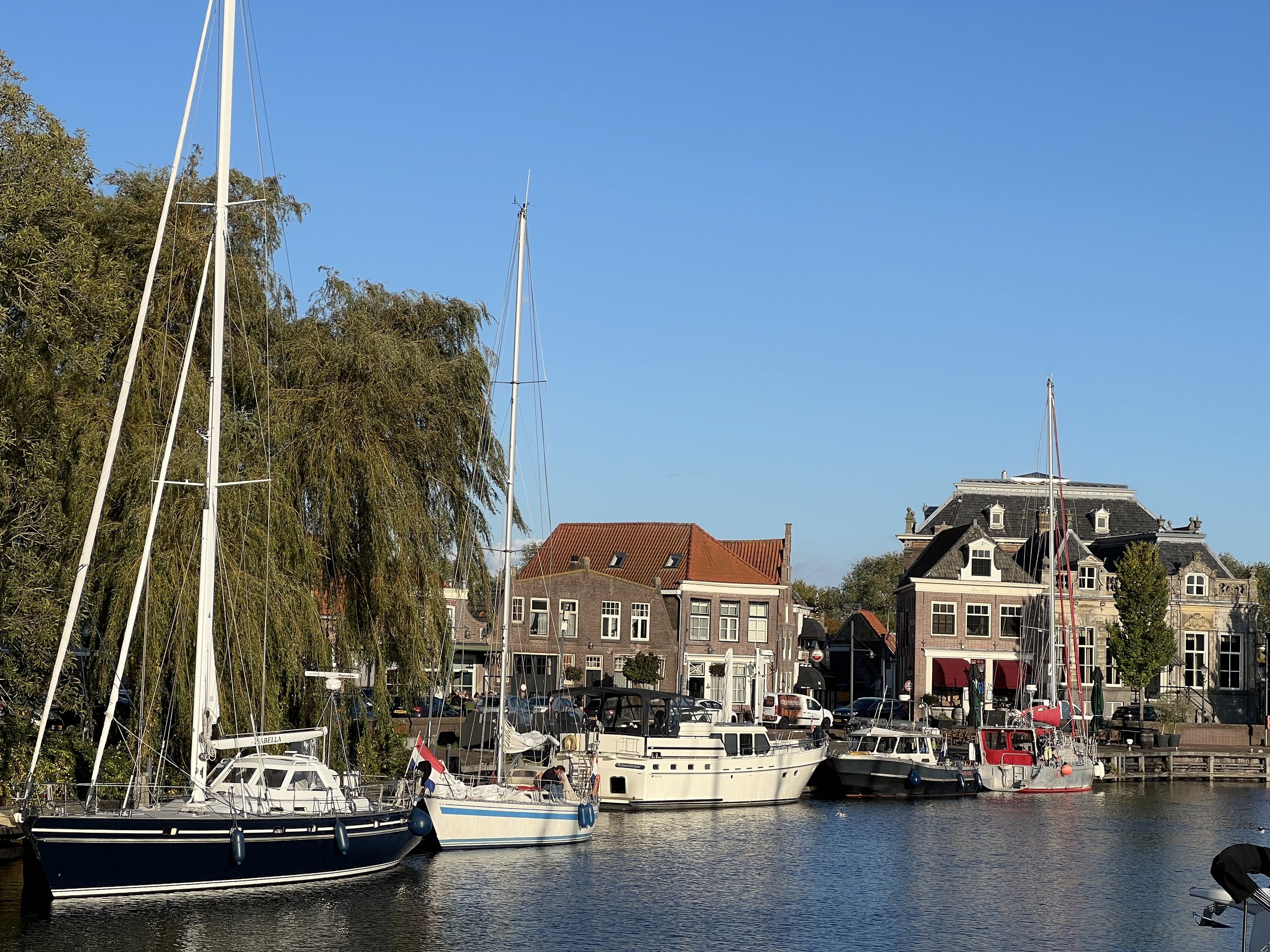A Last Hurrah.
Helacious moored alongside a Dutch canal in Friesland.
The trip from the Kiel canal down the Elbe River to Cuxhaven harbor was a wild ride. We had timed the exit from the canal perfectly to catch the ebb current and we flew down the side of the channel, reaching speeds of 10kt at some points. The problem arises when you want to exit this fast stream and head out of the channel into your harbor. The cross currents were wicked. We were warned of this by Jacob and Anneke, and also followed their track on the chart-plotter, so we knew to approach at a very acute angle. Even with this knowledge, it was high fives all around once we got into the sheltered harbor and were tied up safely.
Old railway station in Cuxhaven.
We waited out some high and contrary winds for a couple of days, then timed our exit to catch the ebb tide again; we ventured forth into the Elbe. The passage from the North Sea into Hamburg is a busy shipping lane and the estuary is extremely shallow, apart from the channel which is heavily dredged to keep it open. In some places there was barely 500ft between the channel marker and the shallows, a mere 5ft depth. Even though we tried our best to stay just outside the channel, avoiding the large ships, at this point we opted to save the boat and move inside the channel. Within 15 minutes we were hailed on the radio by German Naval control, informing us we were in the channel and should exit. We mentioned the shallow water, limited space and very choppy waves, but to no avail. We therefore confirmed we would change course accordingly. We did, but very slowly, finally reaching an area with more depth outside the channel, well after the point where we were challenged. Later, on thinking about this, we confirmed with friends that we were not actually in the wrong. The channel is there for all. It was a little later, exiting the Elbe, that there is a Traffic Separation Zone (TSZ) where there are strict rules for directional travel.
Helacious sailing into the sunset. Photo courtesy of Jacob and Anneke on SV Kim.
The passage was overnight, sailing under a beautiful starlight sky, weaving between parked container ships and fishing vessels, to the entrance between the Frisian Islands. We had arrived in the Netherlands.
There were two options for our journey to the Thames, and our final destination of London. The direct route is along the coast of the Netherlands, where the waters are shallow and there are few safe harbors. The alternative is to journey THROUGH the countryside, along the extensive canal system via a route that has all opening bridges, and as such is known as “Staande Mast Route”, (Standing Mast Route).
Sailing in Norway and Sweden the depths were frequently 50 feet or more just an arm’s length from the rocks. Approaching Holland the channel to enter began over 3 miles off shore, seabirds standing on the sands just 20 feet from our bow. The sands constantly shift, and our charts were incorrect in a couple of places. But we followed the buoys and avoided running aground.
There was a sealock which we entered at Lauwersoog, dropping us about 3ft into the freshwater estuary. As we headed down the channel toward another lock that would drop us even lower, we saw a number of these traditional commercial boats out for a sail. They have a flat bottom with no keel, needing only about 2ft of water to move around. The leeboards on the side of the hull can be lowered in the water when sailing. Perfect design for these waters.
The second lock dropped us a further 6ft into the beginning of the canal system. We travelled in a east to west direction across the northern part of the Netherlands, Friesland. It was beautiful pastoral countryside. The signposts informed us of our route, the side channels lead off into the fields. Friendly folk waved from the banks and at one point we floated over a highway.
Every few miles there was a road bridge that we had to pass through. The procedure was to call them on the radio once we were in sight of the bridge. There was a light system in operation. Red meant it was closed. Once we had called, the bridge attendant prepared the bridge for opening by stopping the traffic. This would sometimes take quite a while, so adjusting our approach speed was always a gamble. The road barriers would descend and the bridge start to open. The lights would change to red and green, meaning approach the bridge. Finally when the bridge was fully open and it was safe to pass, the light would turn green. Then we had to quickly transit, so as not to keep the road traffic waiting too long. All this was fine in light winds, but became increasingly difficult as it became more gusty.
The bridges came in all sorts, mostly cantilevered lifting bridges, but there were some swing bridges and one unique one, where the road section was lifted and twisted off to the side.
In this case we started through too early. It was close!
The distance from Lauwersoog to Harlingen and the IJsselmeer, the large body of water we have to cross to get to Amsterdam, was only 35 miles as the crow flies. However with all the bridges and wonderful small towns along the route, it actually took us 4 days.
Our first stop was Dokkum.
We treated ourselves to lunch, meeting Salvatore, owner of the restaurant. He had just hung up the partially dried tomatoes his mother had sent him from Naples. The food was delicious.
After lunch a walk around the town, to inspect a couple of well restored windmills.
It was possible to climb inside and up to the platform, see where the grain was ground to flour, and check out the sails. They were reefed in high winds, just like a sailboat. Chatting to the guide, he asked if we would like to go higher, past the barrier and up where the cogs and wheels were. The guts of the windmill. Of course we said yes.
Moving on, we enjoyed the Dutch houses, many roofed with a combination of tile and thatch.
The capital of Friesland is Leeuwarden. The Gothic bell tower built in 1500’s leaned alarmingly. There was a reason they did not finish it, they assumed it would fall. The narrow roads lined with elegant houses, many with ornate exteriors made for a pleasant morning stroll.
We moved on, the next stop was the old university town of Franeker. Here we wanted to visit the Eise Eisinga Planetarium, recently awarded UNESCO World Heritage status. In 1774, Eise Eisinga, a wool carder and amateur astronomer started to build a mechanical planetarium in the ceiling of his living room. He built it, in part, to help explain to the townsfolk that the end of the world would not come due to an imminent alignment of the planets.
The main model of the solar system, which is remarkably accurate to this day, has the planetary orbits to scale (exception being Uranus which was not known at that time), moving in real time. Every 4 years it has to be reset, to compensate for leap year.
In addition to the solar system model, the surrounding panels had a clock, a calendar, phases of the moon and other astrological indictors. The board that records the year has to be repainted every 22 years.He left a full instruction manual on how to maintain it, which is used to this day. It was truly remarkable. And there, in the wall was his bed, with the drawer beneath for the children.
The ceiling was dropped down, with the machinery, cogs, pulleys and the pendulum clock that runs all of the action, suspended just above.
One of the orreries on display in the small, but quite delightful planetarium.
Moving on, always moving on. We make our final stop on the Dutch canals in the seaport of Harlingen. Here we get a close up look at the many sea barges that ply the shallow inland seas of Holland. Most are now used as tourist charters, taking guests for cruises up to the Fresian Islands. The traditional rigging and mechanical aesthetic hit home with Brian.
The canals, weaving their way throughout the town, were old. The operating system was rack and pinion. Different from the lever used in Scotland.
Fall had arrived, the leaves were so pretty, but still an indicator we needed to keep moving.
We checked out the traditional blue tilework, and bought a small souvenir. You cannot have large ones on a boat.
Now we were out of the canals and had to sail across the Ijslemeer, a shallow inland sea, toward Amsterdam,. We arrived in Enkhuizen, the half way point, and found the outer harbor full of the huge ships we had admired so much in Harlingen. It turns out it was race weekend. The annual Clipper Race was to start the next day and 29 of these enormous barges were filling the harbor. Fortunately we were able to enter the inner harbor and scored a spot on the wall.
The next day we watched the start of the race. All boats had to anchor out and on the signal the race started, raising the sails and sailing off anchor .
It was quite the spectacle. Once they had gone, we could leave. A couple of days later and we were through Amsterdam, opting to pass on by as we have visited on previous occasions. We staged on the western shore of the Netherlands, waiting for the weather window to cross over to Britain.
This trip through the northern Holland was un unexpected delight. It felt like a last hurrah before we tie our lines up for a six month stay in London. We had intended to pass by Friesland and enter the canals at Harlem and travel south past Rotterdam. However I think we ended up experiencing a gentler side of Holland. The small canals, quaint towns and lovely countryside. And now to make that North Sea crossing…..
Follow our progress on our tracking page. https://forecast.predictwind.com/tracking/display/SVHelacious/


























